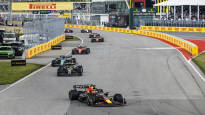According to environmental and responsibility expert Jaana Helminen, F1 could reduce its competition calendar by rationalizing 60 percent of flight kilometers.
This year’s Competition Calendar of the royal class of motor sports, Formula 1, has spoken a lot. The F1 series has stated its goal to be carbon neutral by 2030, but the series has continued to expand. For this year, the flight kilometers have increased.
The increase has caused criticism because the F1 series itself has stated its goals to rationalize the calendar.
According to the F1 series’ own calculations, travel and logistics cause almost 73 percent of the series’ emissions.
This year, the flight kilometers will be at least more than 130,000, i.e. at least three times around the globe. In the series, this season we will fly crisscross and criss-cross around the globe. Finnish F1 star Valtteri Bottas previously told Urheilu that the calendar of the F1 series might see big changes next season.
Environmental and responsibility expert Jaana Helminen has calculated that the F1 series could reduce its flight kilometers by 60 percent. In Helminen’s calculations, the F1 season would still start in Bahrain, and the focus would be to place the races in the same regions.
– First there would be competitions in the Middle East, then in Europe. During the break, the equipment would be shipped to the American continent and still by ship. The series would continue there and then return to Europe via Australia and Japan. That way you could easily get 60 percent off the air miles, says Helminen, who works at Aalto University.
A supporter with a critical attitude towards the environmental goals of the F1 series Toby Miller stated last week to Urheilu that the F1 series does not dare to cut its biggest emissions.
Helminen is on the same lines as Miller, that F1 is holding on to the bullseye at the moment
– Formula 1 drivers often have the impression that the competition event itself would produce a lot of emissions. It’s a false image, says Helminen.
However, Helminen emphasizes that both in the F1 series and in all other sporting events, the focus should be on emissions from travel and logistics.
– Let’s deal with marginally small things. In the Formula 1 races, for example, they try to get public bus transportation to the race location. It’s a really small part of the whole, says Helminen.
A problem with carbon footprint numbers
Last December’s soccer World Cup in Qatar was also advertised as the sport’s first carbon-neutral World Cup.
The international football association Fifa estimates that the emissions of the games would have been 3.6 million tons of carbon dioxide. According to Fifa, it compensates for the emissions, which is why the sports federation considered the games carbon neutral. According to the researchers, the estimates were considerably lower. According to the researchers’ estimate, the emissions were around 10 million tons.
F1 has also not told the background for its own carbon footprint calculations. According to the F1 series’ own readings, the series’ own carbon footprint in 2018 was approximately 256,000 tons. According to the F1 series’ own calculations, it would have been able to reduce its carbon footprint by 17 percent in four years. Last year’s carbon footprint would therefore have been 212,000 tons.
Helminen sees that the readings of the F1 series are valid on a rough level. However, you can’t say for sure.
Helminen sees the problem behind the carbon footprint numbers.
– The problem is that the carbon footprint is calculated in many different ways. I personally think that there should be some rough model by which sports events can calculate their carbon footprint. They would then even be comparable in some way. At the moment, they are not, says Helminen.
In general, the responsibility expert seeks responsibility from the sport’s decision-makers.
– It is pretty much in the hands of those with power in international organizations, what the sports world will look like in the future. If big sporting events, such as F1 circuses, were tried to be organized more sustainably, we could continue to enjoy sports, Helminen emphasizes.
